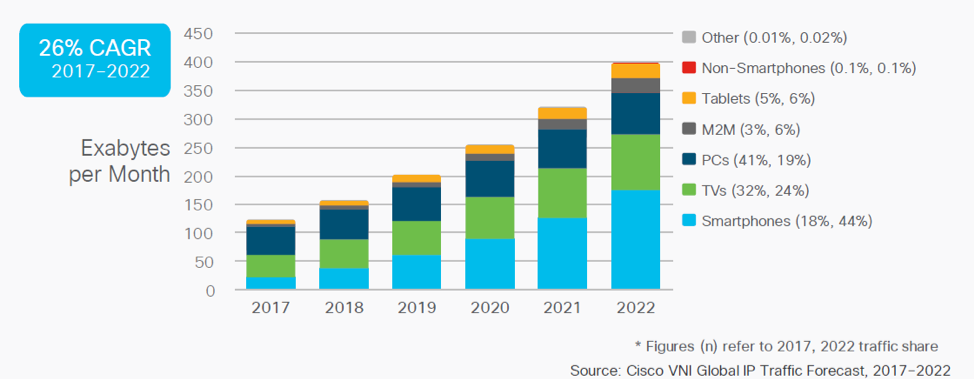
Written by Ray Nering, Product Manager, Transceiver Modules Group, Cisco
Data center network traffic continues to grow, and as always Cisco is here to provide the best infrastructure options for the industry. According to Cisco’s VNI Global IP Traffic Forecast, traffic growth from 2017 to 2022 will have a compounded annual growth of 26%. The number of devices connected to IP networks will increase to more than 28 billion. That’s over 3.5 per capita worldwide!
The chart in Figure 1 shows how the changing mix of devices and connections will affect traffic growth.

Clearly, the need for higher bandwidth networking equipment and connections will continue to be led by market forces. Over a year ago, these forces drove companies like Cisco to introduce switching and routing equipment with 400GE QSFP-DD ports, with aggregate bandwidths in excess of 12Tb/s in a single RU. Those 400GE ports were designed with 8-lane data interfaces operating at 50Gb/s each, which connect directly to the switching/routing ASIC. Since IP traffic is forecasted to continue to grow, so will the demand for higher bandwidth equipment and higher speed ports.
In preparation for the inevitable growth, Cisco along with other along with other industry leaders (Broadcom, Finisar, Intel, Juniper Networks, Marvell, Molex and Samtec) have formed the QSFP-DD800 MSA group to extend the bandwidth of the QSFP-DD pluggable module form factor from 400Gb/s to 800Gb/s. Leveraging the success of the QSFP-DD pluggable form factor for 400Gb/s applications, the new module will continue to be backward compatible with all other generations of QSFP modules including QSFP+, QSFP28, QSFP56 and 400G QSFP-DD. The industry has already invested approximately $9B in QSFP modules over the years. Ports that are backward compatible with lower speed modules give network operators the option to re-use modules they have already invested in. Furthermore, they can aggregate traffic from lower speed ports and manage the migration to next generation equipment without the need to purchase additional port adapters or new modules.
The QSFP-DD800 MSA will focus its initial efforts to define baseline specifications for the module, connector, and stacked connector. It will also define a hybrid connector that is a BiPass/Flyover variant which can eliminate the signal losses on a traditional PCB. They anticipate releasing a baseline specification later this year. Additional members are anticipated to join the MSA to contribute to the requirements.
Choices made in the specifications will take into account not only form factor, but also the progression of technology on the switch/router side. Back in 2017, the IEEE forecasted that switch/router ASIC SERDES speeds will eventually increase to 100Gb/s. In Figure 2, a 100Gb/s lane rate is anticipated to be required for switch bandwidths of 25Tb/s. Currently the IEEE 802.3ck Task Force is working on 100Gb/s SERDES requirements and is scheduled to complete the specification in 2021.

The QSFP-DD800 form factor will therefore be designed for 8 lanes of 100Gb/s SERDES that are expected to be introduced in ASICs for the next generation of silicon and networking equipment. This will help to address the increased global bandwidth consumption by enabling very high bandwidth interfaces.
Initial QSFP-DD800 products are likely to be 2x 400GE modules. Modules such as 2x 400G-FR4 or 400G-DR4 would increase the port bandwidth while maintaining the ability to interface to 400GE modules, which are expected to be widely deployed. Currently there are no standards for optical interfaces for 800GE, and it will likely take several years for those to be established.
The MSA plans to introduce the initial specification in the next few months. Some market forecasters are anticipating product introductions in the next few years. “Our LightCounting forecast model indicates that operators of cloud data centers will need to deploy 800G optics by 2023-24 to keep up with the growth of data traffic,” stated founder and CEO of LightCounting Market Research, Vladimir Kozlov PhD.
Our crystal ball may not be perfect, but we do know that Cisco will be there with optics solutions that are designed to help network operators keep up with traffic growth.

CONNECT WITH US